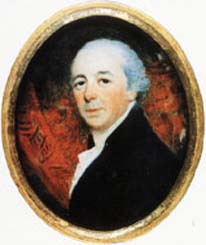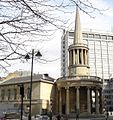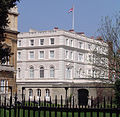| Revision as of 16:42, 18 September 2011 editCecilWard (talk | contribs)Extended confirmed users3,254 editsm Caps, punct← Previous edit | Revision as of 05:18, 21 September 2011 edit undoWhaleto (talk | contribs)934 edits →Work in England and WalesNext edit → | ||
| Line 135: | Line 135: | ||
| *Herman Hill House, ] (c.1794) | *Herman Hill House, ] (c.1794) | ||
| *], ], ] (c.1794) | *], ], ] (c.1794) | ||
| *Kentchurch Court, ] (c.1795) | *Kentchurch Court, ] (c.1795) | ||
| *Llysnewydd, ] (1795) | *Llysnewydd, ] (1795) | ||
| *Whitson Court, near ] (1795) | *Whitson Court, near ] (1795) | ||
Revision as of 05:18, 21 September 2011
For other people named John Nash (disambiguation), see John Nash (disambiguation) (disambiguation).| John Nash | |
|---|---|
 | |
| Born | (1752-01-18)18 January 1752 Lambeth |
| Died | (1835-05-13)13 May 1835 East Cowes Castle |
| Resting place | St. James's Church, East Cowes |
| Nationality | British |
| Occupation | Architect |
| Buildings | Regent Street Royal Pavilion Buckingham Palace Carlton House Terrace |

John Nash (18 January 1752 – 13 May 1835) was a British architect responsible for much of the layout of Regency London.
Biography
Born in Lambeth, London, the son of a Welsh millwright, Nash trained with the architect Sir Robert Taylor. He established his own practice in 1777, but his career was initially unsuccessful and short-lived. After inheriting £1000 in 1778 from his uncle Thomas, he invested the money in 1777-78 in building his first known independent works in Bloomsbury building 15-17 Bloomsbury Square and 66-71 Great Russell Street. But the property failed to let and he was declared bankrupt in 1783 and left London in 1784 to live in Carmarthen, where his mother had retired to, her family being from the area. His first major work in the area being the Gaol at Carmarthen 1789-92. He also designed a series of medium sized country houses in south-west Wales including Llanerchaeron. He met Humphry Repton at Hafod Uchtryd in 1795, he formed a successful partnership with the landscape garden designer. One of their early commissions was at Corsham Court. The pair would collaborate to carefully place the Nash-designed building in grounds designed by Repton. Eventually, Nash returned to work in London, in 1795. The partnership ended in 1800 under recriminations, Repton accusing Nash of exploiting their partnership to his own advantage.
His first significant commission on returning to London in 1795-6 was Hereford gaol. In June 1797 he moved into 28 Dover Street a building of his own design, he built an even bigger house next door at 29 into which he moved the following year. Nash married Mary Ann Bradley on the 17th December 1798 at St George's, Hanover Square. The bride was 25 years old. In 1798 he purchased a plot of land of 30 acres (120,000 m) at East Cowes. On the land he erected 1798-1802 East Cowes Castle as his residence. This was the first of a series of picturesque Gothic castles that he would design.
In 1806 Nash was appointed architect to the Surveyor General of Woods, Forests, Parks, and Chases. From 1810 Nash would take very few private commissions. Nash was a dedicated Whig and was a friend of Charles James Fox through whom Nash probably came to the attention of the Prince Regent (later King George IV) and for the rest of his career he would largely work for the Prince. His first major commissions in 1811 from the Prince was Regent Street and the development of an area then known as Marylebone Park. With the Regent's backing (and major inputs from Repton), Nash created a master plan for the area, put into action from 1818 onwards, which stretched from St James’s northwards and included Regent Street, Regent's Park and its neighbouring streets, terraces and crescents of elegant town houses and villas. Nash did not complete all the detailed designs himself; in some instances, completion was left in the hands of other architects such as James Pennethorne and the young Decimus Burton. Nash was employed by the Prince to develop his Marine Pavilion in Brighton, originally designed by Henry Holland. By 1822 Nash had finished his work on the Marine Pavilion, which was now transformed into the Royal Pavilion.
Nash was also a director of the Regent's Canal Company set up in 1812 to provide a canal link from west London to the River Thames in the east. Nash's masterplan provided for the canal to run around the northern edge of Regent's Park; as with other projects, he left its execution to one of his assistants, in this case James Morgan. The first phase of the Regent's Canal opened in 1816. Together with Robert Smirke and Sir John Soane, he became an official architect to the Office of Works in 1813.
In 1820 a scandal broke about Nash, a cartoon was published showing a half dressed King George IV embracing Mrs Nash with a speech bubble coming from the King's mouth with the words "I have great pleasure in visiting this part of my dominions". Whether this was based on just a rumour put about by people who resented Nash's success or if there is substance behind is not known.
Further London commissions for Nash followed, including the remodelling of Buckingham House to create Buckingham Palace (1825–1830), plus the Royal Mews and Marble Arch, originally designed as a triumphal arch to stand at the entrance to Buckingham Palace. The arch was moved when the east wing of the palace designed by Edward Blore was built, at the request of Queen Victoria whose growing family required additional domestic space. Marble Arch became the entrance to Hyde Park and The Great Exhibition.
He advised on work to the buildings of Jesus College, Oxford, for which he required no fee but asked that the college should commission a portrait of him from Sir Thomas Lawrence to hang in the college hall.
Nash's career effectively ended with the death of George IV in 1830, the King's notorious profligacy with money had generated much resentment and Nash was now without a protector. The Treasury started to look closely at the cost of Buckingham Palace, Nash's original estimate of the building's cost had been £252,690, but this had risen to £496,169 in 1829 the actual cost was £613,269 and the building still wasn't finished. This controversy ensured that Nash would not receive any more official commissions nor would he be awarded the Knighthood that other contemporary architects such as Jeffry Wyattville, John Soane & Robert Smirke received. So he retired to the Isle of Wight where he died on the 13th May 1835 in his home, East Cowes Castle, and is buried at St. James's Church, East Cowes.
Nash had many pupils including Humphry Repton's sons, John Adey Repton (1775–1860) & George Stanley Repton (1786–1858), as well as Anthony Salvin, John Foulon (1772–1842), Augustus Charles Pugin, James Morgan & James Pennethorne.
Work in London
-
 All Souls Langham Place
All Souls Langham Place
-
 The interior looking east, All Souls Langham Place
The interior looking east, All Souls Langham Place
-
 The interior looking west, All Souls Langham Place
The interior looking west, All Souls Langham Place
-
 The interior looking north, All Souls Langham Place
The interior looking north, All Souls Langham Place
-
 Bust of John Nash, in the portico, All Souls Langham Place
Bust of John Nash, in the portico, All Souls Langham Place
-
 The Rotunda Woolwich
The Rotunda Woolwich
-
Cumberland Terrace
-
 Cumberland Terrace
Cumberland Terrace
-
 Carlton House Terrace
Carlton House Terrace
-
Theatre Royal Haymarket
-
Buckingham Palace Garden Front
-
 Buckingham Palace East front as designed by Nash
Buckingham Palace East front as designed by Nash
-
 The Royal Mews, Buckingham Palace
The Royal Mews, Buckingham Palace
-
 Park Crescent
Park Crescent
-
 East side, Park Square
East side, Park Square
-
 West side, Park Square
West side, Park Square
-
 Marble Arch
Marble Arch
-
 Chester Terrace
Chester Terrace
-
 Detail, Chester Terrace
Detail, Chester Terrace
-
 Clarence House
Clarence House
-
Former United Services Club
-
 Regent Street, since rebuilt
Regent Street, since rebuilt
-
 Nash's plan for Regent Street
Nash's plan for Regent Street
-
 conservatory, Kew Gardens
conservatory, Kew Gardens
-
King's Opera House, demolished
-
Royal Opera Arcade
- Park Crescent, London (1806, 1819–21)
- Regent Street (1809–1826)
- Regent's Park (1809–32)
- Regent's Canal (1811–1820)
- Royal Lodge (1811–20) subsequently remodelled by Sir Jeffry Wyattville
- Carlton House, London remodelled several interiors, (1812–14) demolished 1825 to make way for Nash's Carlton House Terraces
- Trafalgar Square (1813–30) completely redesigned by Sir Charles Barry
- The Rotunda, Woolwich (1814) & (1820)
- St. James's Park (1814–27)
- The King's Opera House, Haymarket on the site of Her Majesty's Theatre The Royal Opera Arcade is the only part still standing (1816–18)
- Waterloo Place (1816)
- Haymarket Theatre (1820–21)
- 14-16 Regent Street (Nash's own house) (1820–21)
- York Gate (1821)
- the Church of All Souls, Langham Place (1822–25)
- Hanover Terrace (1822)
- York Terrace (1822)
- Royal Mews (1822–24)
- Sussex Place (1822–23)
- Albany Terrace, London (1823)
- Park Square, London (1823–24)
- Park Village East & West (1823–34)
- Cambridge Terrace (1824)
- landscaped King's Road (1824)
- Ulster Terrace (1824)
- Buckingham Palace the state rooms and western front (1825–30), since much extended by James Pennethorne, Edward Blore & Aston Webb
- Chester Terrace (1825)
- Clarence House (1825–27)
- Cumberland Terrace (1826)
- Former United Services Club Pall Mall now Institute of Directors(1826–28)
- Gloucester Terrace (1827)
- Carlton House Terrace (1827–1833)
- Marble Arch (1828)
- 430-449 Strand (1830)
The changes made by John Nash to the streetscape of London are documented in the film, "John Nash and London", featuring Edmund N. Bacon and based on sections of his book Design of Cities.
Work in England and Wales
-
Llanerchaeron
-
 East Cowes Castle, demolished
East Cowes Castle, demolished
-
 Blaise Hamlet
Blaise Hamlet
-
 Blaise Hamlet
Blaise Hamlet
-
 Circular Cottage, Blaise Hamlet
Circular Cottage, Blaise Hamlet
-
 Entrance to Attingham Park
Entrance to Attingham Park
-
 Cronkhill
Cronkhill
-
 Caerhays Castle
Caerhays Castle
-
 The Royal Pavilion Brighton
The Royal Pavilion Brighton
-
 The Royal Pavilion Brighton
The Royal Pavilion Brighton
-
 The entrance, The Royal Pavilion Brighton
The entrance, The Royal Pavilion Brighton
-
 Banqueting Room, The Royal Pavilion Brighton
Banqueting Room, The Royal Pavilion Brighton
-
 The kitchen, The Royal Pavilion Brighton
The kitchen, The Royal Pavilion Brighton
-
 Ingestre Hall
Ingestre Hall
-
 Witley Court
Witley Court
-
Hafod Uchtryd
Elsewhere in England and Wales, his work included:
- The stable block at Plas Llanstephan (1788)
- Carmarthen Gaol, (1789–92)
- St David's Cathedral, new west front (1789–1791) completely remodelled by Sir George Gilbert Scott in 1862.
- Clytha Castle, 1790
- Ffynone House, Boncath (1792–96)
- Sion House, Tenby (1792)
- South Sion Lodge, Tenby (1792)
- Cardigan Gaol, (1793)
- Foley House, Haverfordwest, Pembrokeshire (1794)
- Hafod Uchtryd, remodelling (1794) demolished 1958.
- Herman Hill House, Haverfordwest (c.1794)
- Llanerchaeron, Ciliau Aeron, Ceredigion (c.1794)
- Kentchurch Court, Pontrilas (c.1795)
- Llysnewydd, Henllan, Ceredigion (1795)
- Whitson Court, near Newport (1795)
- Glanwysc Villa, Llangattock (Crickhowell) (c.1795)
- Temple Druid House, Maenclochog (1795)
- Castle House, later extended to form Old College Aberystwyth University, (1795)
- Blaise Castle, additions, including the conservatory and various buildings in the grounds, dairy, gatehouses e.t.c. (1795-c.1806)
- The Priory Cardigan, Ceredigion (1795)
- Hereford Gaol (1796)
- Corsham Court, remodelling work, only his east front survives, (1796–1813)
- Grovelands Park, Enfield, Middlesex (1797)
- Atcham, several houses in the village (1797)
- Attingham Park, new picture gallery and entrance lodges (c1797-1808)
- East Cowes Castle on the Isle of Wight (1798–1802) – his home until his death in 1835, demolished 1960.
- Sundridge Park, Sundridge, London, (1799)
- Chalfont House, Chalfont St Peter, remodelled (1799–1800)
- Helmingham Hall, modernisation work (1800–1803)
- Luscombe Castle (1800–1804)
- Cronkhill, near Shrewsbury, Shropshire. First Italianate villa in Britain. (1802)
- Longner Hall, Atcham, remodelling and extension (1803)
- Nunwell House, Nunwell Isle of Wight (1805–07)
- Sandridge Park (1805)
- Witley Court (1805–06)
- Market House Chichester (1807)
- Ravensworth Castle (1808)
- Caerhays Castle, Cornwall (1808)
- Ingestre Hall (1808–1813)
- Blaise Hamlet, Bristol (1810–11)
- Guildhall Newport, Isle of Wight (1814)
- rebuilding of the Royal Pavilion at Brighton (1815–1822)
Work in Ireland
Nash designed several works in Ireland:
- House for Countess Shannon, County Cork. 1796. Unbuilt.
- Ballindoon House (c.1800) Kingsborough, Derry, County Sligo for Stafford-King-Harmon family. House and stable block.
- Killymoon Castle, near Cookstown, County Tyrone, (1801-7)* . Castle originally built in 1671. Rebuilt in Norman style by Nash for Col. William Stewart at an alleged cost of £80,000. Now well maintained as home of the Coulter family. The parkland is now used as a golf course.
- Lissan Rectory, County Londonderry. 1807. Italianate Villa.
- Kilwaughter Castle, Larne, County Antrim. (1807). New castillated mansion built for E.J. Agnew incorporating an earlier house. Demolished 1951.
- Caledon House, County Tyrone, (1808–10) for Earl of Caledon. Enlargement and embellishment of an earlier house ( 1779) by Thomas Cooley with two single storey domed wings connected by a colonnade of coupled Ionic columns. Nash redecorated the oval drawing room.
- Aras an Uachtarain, Phoenix Park, Dublin. (Former Vice-Regal Lodge, now President's residence) 1808. Entrance lodges only.
- St John's Church Caledon, Count Tyrone (1808). Alterations including timber spire. Spire replaced in stone to same design 1830.
- St. Paul's Church of Ireland church in Cahir, South Tipperary.1816-1818. Cruciform plan. Allegedly Nash's best Gothic revival church.
- Rockingham House, Boyle, County Roscommon (1810). Originally two storey with curved central bow, fronted by a semi-circular Ionic colonnade, and surmounted by a dome. Built for the King Harmon family. Extra floor added by others. Burnt in fire 1957. Subsequently demolished. Parkland now a public park and amenity.
- Rockingham lakeside gazebo.
- Rockingham Gothic Chapel. Roofless.
- Rockingham Castle. Nash may have contributed to picturesque island castle ruin.
- Swiss cottage, Cahir County Tipperary.(1810–14) Cottage ornee.
- City Gaol, Limerick City, County Limerick. 1811-1814. New Gaol.
- Lough Cutra Castle, Gort, County Galway(1811–1817) . Built for Charles Vereker subsequently Viscount Gort.
- Shane's Castle (1812–16). Alterations to 17th.century castle for 1st. Earl O'Neill consisting lakeside terrace, and battlemented conservatory with round headed windows, watch-tower and look-out. Burnt down 1816 before Nash's plans were completed and abandoned.
- Burne Lodge. Crawfordsburn House, Co. Down. 1812. 2 storey gate lodge with octagonal room at first floor level.
- Shanbally Castle, near Clogheen, South Tipperary (1818–19). Built for Cornelius O'Callaghan, 1st. Viscount Lismore.Largest of Nash's Irish Castles. Has similarities with Luscombe Castle, Devon. Demolished and dynamited 1960.
- Gracefield Lodge, County Laois, for Mrs. Kavanagh. 1817.
- Erasmus Smith School, Cahir, County Tipperary. 1818.
- Tynan Abbey, Tynan, County Armagh. 1820. Remodelled in Tudor gothick style for Sir James Stronge. gutted by fire 1980. Drawings destroyed after being photographed.
- St. Laurence Church of Ireland, Derryloran Parish. 1822. Cost £2,769.4s.71/2d. Early English style. Rebuilt 1859-61.
- Woodpark Lodge, Co. Armagh. Alterations. 1830's.
- St. Beaidh church, Ardcarne, Co.Roscommon. Alterations including tower which was an eyecatcher to Rockingham House.
- Somerset House, Coleraine for Mr. Richardson. Date not known. Unexecuted.
- Mountain Lodge, Co. Tipperary for Viscount Lismore. Date not known. Now in use as youth hostel.
- Castle Leslie, County Monaghan. Date not known. Gateways and gate lodge.
- 80-82 Chapel Street, Cookstown, County Tyrone. Dower house to Killymoon. Date not known.
- Finaghy House, Belfast, Co. Armagh. Gatelodge. Date not known.
- Quaker Meering House, Branch Road, Tramore, County Waterford. 1869.
References
- page 16, Terence Davis, John Nash The Prince Regent's Architect, 1966 Country Life
- page 119,Humphry Repton, Dorothy Stroud, 1962, Country Life
- page 30, the Life and Work of John Nash Architect, John Summerson, 1980, George Allen & Unwin
- page 20, East Cowes Castle The Seat of John Nash Esq. A Pictorial History, Ian Sherfield, 1994, Canon Press
- page 73, the Life and Work of John Nash Architect, John Summerson, 1980, George Allen & Unwin
- pages 20-21, Terence Davis, John Nash The Prince Regent's Architect, 1966 Country Life
- page 151, the Life and Work of John Nash Architect, John Summerson, 1980, George Allen & Unwin
- Baker, J. N. L. (1954). "Jesus College". In Salter, H. E.; Lobel, Mary D. (eds.). A History of the County of Oxford Volume III – The University of Oxford. Victoria County History. Research, University of London. p. 275. ISBN 9780712910644. Retrieved 23 June 2009.
{{cite book}}: External link in|chapterurl=|chapterurl=ignored (|chapter-url=suggested) (help) - page 177, the Life and Work of John Nash Architect, John Summerson, 1980, George Allen & Unwin
- page 30, Buckingham Palace, John Harris, Geoffrey de Bellaigue & Oliver Miller, 1969, Thomas Nelsons & Sons
- http://www.britannica.com/EBchecked/topic/403844/John-Nash
- The lists of works on this page are based on: John Nash A complete catalogue, Michael Mansbridge, 1991, Phaidon Press
- Pevsner, Nikolaus Cornwall; Buildings of England series. (1951; 1970) (rev. Enid Radcliffe) Penguin Books (reissued by Yale U. P.) ISBN 0-300-09589-9; p. 192
- "John Nash". Dictionary of Ulster Biography. Retrieved 2008-07-09.
- "1752 Jupiter". Wisdom Portal.